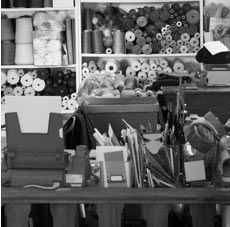Antonietta Airoldi
atelier di tessitura
CH-6960 Pezzolo - Odogno
Mobile: 076/396 53 33
e-mail: antonietta@bluewin.ch

picture: Giuseppe Pennisi
A concrete ideal project
Maria Will
At the center of Antonietta Airoldi's work lies the individual. There lies the thought for man, similar among similar people engaged in the journey, in the ordeal perhaps, of life. This man is naked and it is necessary to provide him with clothing; he has no home, or, if even, his home is cold and unadorned, and it is necessary to provide him with which to shelter and find comfort.
It will be immediately understood how such work has in the symbolic dimension its fundamental key. The thread that, weave after weave, gives birth on the loom to the desired weave, writes messages to be released in the turn of a dance step or in the arc swelled by a gust of wind. If the use of color in this order of ideas, that is, in this kind of linguistic code, assumes an absolutely fundamental role, it will be seen how Antonietta Airoldi's landing to the making of liturgical garments turns out to be an entirely natural - and almost predestined - evolution of her research, all directed towards overcoming the everyday; or rather, to a renewed awareness of its meaning.
In fact, the rituality observed in devotional practices and ceremonies constitutes the accomplished manifestation and risen to the norm - popular, that is, in the end, social - of a "sacredness" perceived, even outside of a properly religious thought and sphere, as a constant counterpoint that rhythms the human seasons in their flat and prosaic unfolding. From here, the step to figuring a continuous theater, which with its cadenced movements frames and enhances the sense and taste of living, is indeed a short one. The artist then becomes the director of an ordering action, of a plan for well-being and happiness: what better and higher task, what more beautiful utopia can we ask of art?
The process that leads to the finished work is equivalent for Antonietta Airoldi to a real construction, to the "building" of a project: the thread, a slender entity with strong possibilities and a wide-ranging metaphorical value, is what makes it feasible and real. In the choice of material - silk favored along with linen but also "borrowed" fibers for special insertions, such as fishing wire or copper wire or paper threads, suitable for obtaining a special fabric response - the author's sensitivity considers its characteristics not only in aesthetic function. Indeed, not only for the enjoyment of the eye does Antonietta Airoldi work; of basic importance in her research is also the evaluation of the sensations transmitted through touch (an evaluation to which the artist is surely already led by reason of the great manual skill involved in weaving).
In designs of bare simplicity, where one senses the will and the need for method to restrict oneself within forms of primary, primordial if you will, definition (cloaks-jackets, tunics), the expression of sumptuousness that nevertheless characterizes Antonietta Airoldi's pieces, is entrusted to the fabric itself, to its structure - given by the body of the different fibers and the different processes - and to its color: the precious reds, the shiny blacks or bottoms, the warm whites.
Colors that came to determine successive stages of development in the research, one after another investigated and penetrated. Next to color, it is light that intrigues the artist, who captures it and gives it play to the point of stretching a fragile net of transparencies. It could also be said that a kind of feeling of purification remains attached to these textile works, as an intrinsic given of recognition.
Asymmetrical profiles, sharp-edged architectural cuts and the play of folds that can conceal cascades of color, even the exclusive choice of pleating as the costutive factor of a work - a work that is always a "unique piece," obtained in a single cast on the loom made up of infinite gestures - do not contradict the underlying approach, averse to extraneous to any artifice; if anything, they make it more explicit. This strict adherence to the principle of simplicity is also answered by the predilection for the square, a figure of maximum finiteness and concreteness. As concrete is the work of Antonietta Airoldi within a tension of lived ideality.





